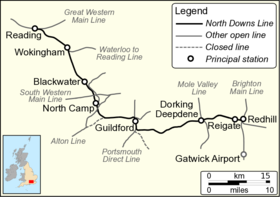North Downs Line
| North Downs Line | |
|---|---|

North Downs Line
|
|
| Overview | |
| Type | Suburban rail, Heavy rail |
| System | National Rail |
| Status | Operational |
| Locale | Berkshire, Hampshire, Surrey |
| Termini |
Reading Redhill Gatwick Airport |
| Operation | |
| Opened | 1849 |
| Owner | Network Rail |
| Operator(s) |
Great Western Railway Southern South West Trains CrossCountry |
| Depot(s) | Reading TMD |
| Rolling stock |
Class 165 Class 166 Class 377 Class 456 Class 458 Class 450 Class 220 Class 221 |
| Technical | |
| Track gauge | 1,435 mm (4 ft 8 1⁄2 in) standard gauge |
| Electrification | 3rd rail, 750 V DC (Reading to Wokingham - Aldershot South Junction to Shalford Junction - Redhill to Reigate) |
| Operating speed | 70 mph (110 km/h) (maximum) |
The North Downs Line is a passenger-train line connecting Reading, on the Great Western Main Line, to Redhill and Gatwick Airport, along the Brighton Main Line, linking many centres of population in that part of the North Downs which it traverses en route.
Between Redhill and Ash the line runs roughly parallel with the North Downs. Between Reigate and Gomshall the line runs along the foot of the North Downs escarpment in the Vale of Holmesdale. At Guildford it passes through the gap in the Downs formed by the River Wey, with a short tunnel just south of Guildford station, and further west between Guildford and Ash the line runs to the north of the Hog's Back. It then follows the Blackwater valley as far as Sandhurst, before continuing to Reading.
The line was authorised by Acts of Parliament in 1846 and 1847 and most of it was constructed by the Reading, Guildford and Reigate Railway Company (RG&RRC), opening in 1849. (A central section of the line near Guildford was built by a predecessor of the LSWR.) The stated objective of the company was to
"secure through traffic passing between the West, North and Midlands and the Channel Ports avoiding the congestion of London and thus saving time, distance and expense."
Although the company had some independent shareholders, it was closely associated with the South Eastern Railway (SER). The original intention was for the SER to build part of the line itself, but this proposal was rejected by Parliament. The independence of the company was only a formality to satisfy Parliament. The two companies had some common directors; a SER engineer controlled the construction of the line. As intended at outset, the line was leased to the SER in 1850, and the two companies finally merged in 1852. The company's relationship with the GWR is described as "enigmatic". The GWR initially offered the company the use of its facilities at Reading station but terms could not be agreed and a separate station was built.
...
Wikipedia
